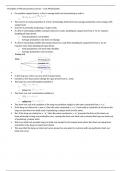Class notes
Principles of Microeconomics Lecture 16 – Cost Minimization Part 2
- Course
- Institution
- Book
These are the 2nd half of the notes to cost minimization. these notes cover long-run and short-run costs. Additionally they cover fixed and quasi-fixed costs.
[Show more]



